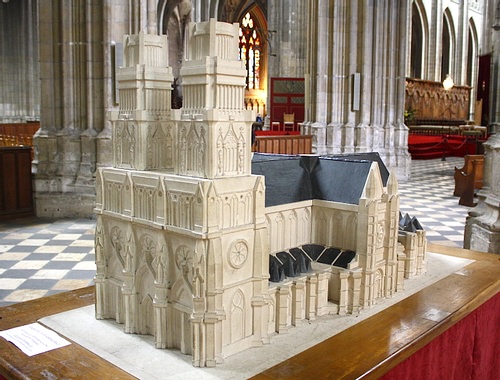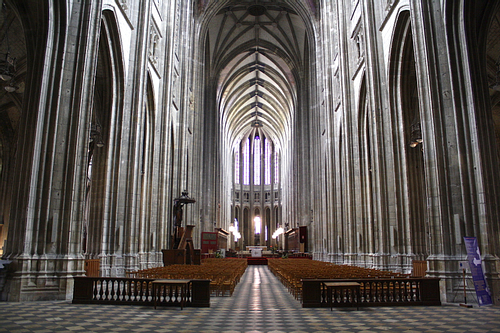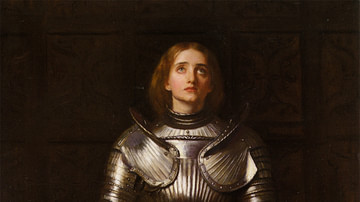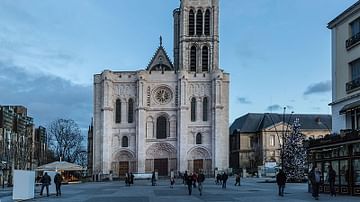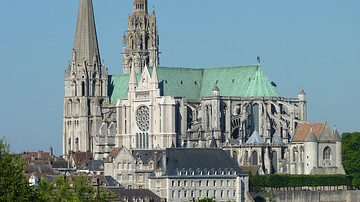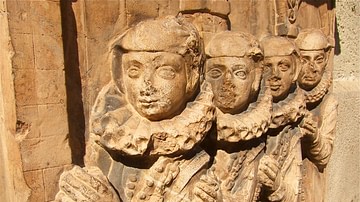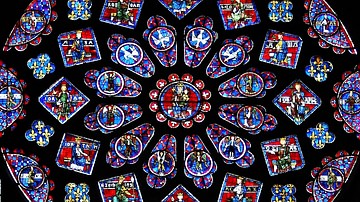
The Cathedral of the Holy Cross (Sainte-Croix) of Orleans in the Centre-Val de Loire region of France, was first built in the 13th century CE on the site of a series of older churches dating back to the 4th century CE. The cathedral, which hosted the coronations of several French kings, was added to over the centuries and is a splendid example of both the Gothic and Classical styles of architecture. It is very similar in both design and dimensions to the Cathedral of Notre-Dame in Paris. In many ways, the cathedral is a monument to the city's great heroine, Saint Joan of Arc (c. 1412-1431 CE) who saved Orleans during the Hundred Years' War (1337 - 1453 CE) between France and England. A chapel in the apse is dedicated to the saint, and her life story is told in ten of the cathedral's stained glass windows.
Earlier History
Today's cathedral was built on the site of a much older church, built by Saint Euverte, the Bishop of Orleans, c. 375 CE. Saint Euverte claimed to have seen a vision in which the hand of God appeared in the sky to bless the church on its foundation. The hand symbol still appears today on the keystone of the chancel ceiling. The spot had an even more ancient religious association than Euverte's church, though, as archaeology has revealed the remains of some sort of structure, perhaps a Roman pagan temple, which dates to the 1st century CE. A small section of the wall of the 4th-century CE Roman church can be seen on the north side of the cathedral, and there are also some remains preserved in the crypt.
In the 5th century CE, a basilica replaced the older church, and it proved to be a useful place of refuge during the attacks in the region by Attila the Hun in 451 CE when Orleans was besieged. A portion of a once huge 8th-century CE circular floor mosaic can still be seen today in the cathedral's crypt. Revamped again in the 9th century CE, the church now assumed the familiar cross shape of Christian churches. In 848 CE the structure was impressive enough to host Charles the Bald's coronation as King of West Francia, and in 888 CE King Odo of West Francia had his coronation ceremony in the cathedral, too.
Disaster then struck in 989 CE when the church - and most of the town - was gutted by a tremendous fire but this provided an opportunity to build a bigger and better church than ever before. The Kings of the Franks, Hugues Capet (r. 987-996 CE) and his son Robert the Pious (996-1031 CE), saw to it that Bishop Arnoul I had sufficient funds to construct a great new Romanesque cathedral which was completed c. 1000 CE. In 1087 CE the apse was extended, and in 1107 CE a towered facade added which had three large doorways. The same year Louis VI the Fat (r. 1107-1137 CE), King of the Franks, was crowned in the cathedral. The essential blueprint for the later Gothic cathedral was now established, and the building, the largest of its kind in France at the time, was already attracting pilgrims from far and wide.
Cathedral of the Holy Cross
By the 13th century CE, the cathedral proved a little too large for its foundations and there occurred structural problems caused by subsidence. Attempts to strengthen the foundations failed, and there was even a partial collapse of the north aisle in 1278 CE and again in 1286 CE. The faithful were now too afraid to enter the cathedral and so a massive rebuilding project was undertaken.
Work began on 11 September 1287 CE but, interrupted by various wars, the project would take over 250 years to finish. The old towers of the facade were kept but the rest of the building was constructed on a higher level than the previous Romanesque version and extended out much further on all four sides. The new chancel was completed by the end of the 13th century CE, and over the next century side chapels were added to the apse and the nave was almost completed. Work was suspended during the Hundred Years' War but Joan of Arc visited and prayed in the cathedral on 29 April 1429 CE when the city was under siege by English forces. In the mid-15th century CE work finally resumed and the Gothic transept and nave were finished and a bell and clock tower added so that by 1530 CE the massive Cathedral of the Holy Cross was finally completed.
Exactly when the cathedral acquired its name is unclear but legend has it that a fragment of the Holy Cross on which Jesus Christ was crucified was given by the Holy Roman Emperor Charlemagne (l. 742-814 CE) to Theodulf, the Bishop of Orleans (r. 788-818 CE), in the 9th century CE. However, the church's association with the Holy Cross goes back earlier than that with local coins dating to c. 670 CE bearing the legends Sancta Crux Aurelianis and Ratio Sancte Crucis Aurelianis (Aurelianis being the original Gallo-Roman name for Orleans). It was the presence of this holy relic and others like Saint Euverte's chalice which attracted pilgrims from across France and Europe to visit Orleans' great cathedral.
16th-19th Century Reconstructions
It may have taken centuries to finally finish but in 1568 CE, less than 40 years after the stone masons had downed their tools, the building was partially destroyed by Protestant Ultras, the Huguenots, who blew up four columns and brought the steeple and a good number of arches crashing down into the nave. Fortunately, the king of France, Henry IV (r. 1589-1610 CE), funded a rebuilding project which began in the 17th century CE and which eventually restored the cathedral to its former glory. Notable additions were flying buttresses on the outside, vaults to the transept on the inside, and replacing the old Gothic facades of the transepts with new ones which reflected the fashionable mix of Italian Gothic and Classical styles. In the late 18th century CE the original Romanesque towers of the facade were replaced by the more intricate and imposing towers seen today. In 1858 CE the main bell tower above the transept crossing was replaced by a slender steeple, again in the Gothic style to create a more harmonious exterior. As a final touch, bells were added to the front towers in 1898 CE.
![Model of Orleans Cathedral [Rear View]](https://www.worldhistory.org/img/r/p/500x600/10500.jpg?v=1599152403)
Unfortunately, the building suffered yet another catastrophic blow during the Second World War (1939-45 CE) when the two front towers were damaged and many of the stained glass windows were shattered. Once again, the cathedral was painstakingly restored and, even today, it continues to benefit from the attention of a large team of restorers as they work on the main portals of the facade and the exterior of the apse.
Design
The key dimensions of the cathedral as we see it today are:
- total length: 136 m (446 ft)
- width including transepts: 53 m (174 ft)
- height of facade towers: 81 m (265 ft)
- height of steeple: 106 m (347 ft)
- height of nave vaulting: 32 m (105 ft)
- width of nave: 40 m (131 ft)
The cathedral from the outside is dominated by its massive two-towered facade which has five monumental portals above which are three openwork rose windows and an open gallery. Countless spires, elaborate flying buttresses, and the towering main steeple combine to present the viewer with a bristling array of Gothic architectural features.
On entering the main portal, one is presented with a nave which is long, luminous, and extremely high-ceilinged. The nave is surprisingly austere but calming, a marked contrast to the busy and elaborate decoration of the cathedral's exterior. A series of plain columns and arches create an aisle on each side while midway down the semi-transepts branch off either side.
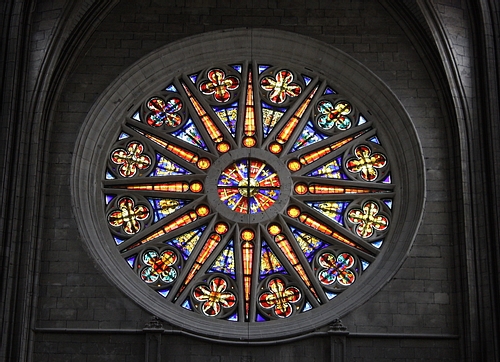
The cathedral's apse has a wide ambulatory for pilgrims to walk around and branches off into 13 chapels, each dedicated to various saints, including Saint Louis, the French king Louis IX (r. 1226-1270 CE) who led the Seventh Crusade and the Eighth Crusade. Many of the chapels are exquisitely painted and, unusually, have human heads on their ceiling keystones - a feature also seen in Paris' Notre-Dame cathedral.
Stained Glass Windows
The cathedral boasts many fine stained glass windows although all of them except the transept rose windows date to the mid-19th century CE or later as previously there were only plain glass windows throughout. There are ten large coloured windows - five on each side of the nave at the main entrance end - showing scenes from the life of Saint Joan of Arc, heroine and saviour of Orleans in 1429 CE during the Hundred Years' War between England and France. Joan of Arc also has one of the apses' chapels dedicated to her (the first on the left side as one faces the apse). Based on medieval tapestries and manuscript illustrations, they show such iconic scenes as Joan hearing angelic voices instructing her to defend France, entering Orleans in full knight's armour, praying in the cathedral, and her untimely end, burnt at the stake at Rouen having been found guilty of witchcraft and heresy.
The transept has a large rose window at either end, which depict the royal sun at its height on the south side and the setting sun on the north side. Both windows, filled in 1679 CE, were thus made to represent the Sun King Louis XIV (r. 1643-1715 CE).
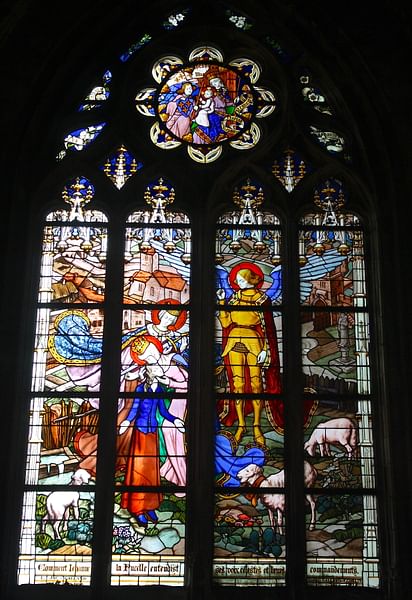
Other windows show scenes of King Henry IV of France who generously funded the cathedral's repairs following the damage done during the religious wars that wracked the country in the second half of the 16th century CE. One such window shows the king laying a stone column base on 18 April 1601 CE. Finally, the windows in the choir and chapels show, amongst others, scenes of the Passion of Christ and the history of the reconstruction of the cathedral.
Sculptures
The church boasts two massive and ornate altars carved from Russian oak in the 19th century CE. The Altar of the Virgin on the northern side dates to 1872 CE and shows four high relief scenes of the Presentation, Marriage Feast, Annunciation, and Flight into Egypt. On the southern side, the Altar of the Sacred Heart (1868 CE) shows four scenes: the Last Supper, Mount of Olives, Crucifixion, and Ascension.
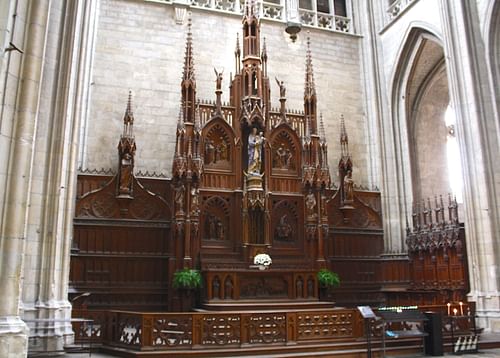
Other sculptures include the 21 oval medallions in the chancel, also carved from wood, which were commissioned by Louis XIV. The panels depict scenes from the life of Jesus Christ and are set into the 95 choir stalls which were, along with the wooden bishop's throne in their centre, also designed by Louis XIV's best craftsmen, fresh from their work at the palace of Versailles. The Holy Sacrament Chapel has a 17th-century CE sculpture of the Pieta by Michel Bourdin, while the Chapel of Saint Joan of Arc has an early 20th-century CE marble statue of the heroine by Vermare with another figure in front of it representing a kneeling Cardinal Touchet who was instrumental in the call to canonise she who did so much to protect the city of Orleans.
